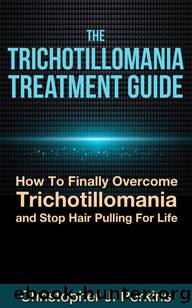The Trichotillomania Treatment Guide by Christopher J. Perkins

Author:Christopher J. Perkins
Language: eng
Format: epub
Tags: Fachbücher
Publisher: Christopher J. Perkins
Published: 2016-03-05T23:00:00+00:00
Chapter 5: Treatment
Fortunately, there are many options which can successfully treat trichotillomania. Some treatment options are self-guided while others require or recommend professional assistance. As each person is different, there is no one size fits all option and thus the following treatment options are worth being explored.
SELF-GUIDED TREATMENT OPTIONS
Natural Herbs
There are a number of herbs which have been found to be helpful in treating trichotillomania and/or related disorders such as obsessive-compulsive disorder (OCD). As established above, the DSM-V classifies trichotillomania as related to OCD. It follows that these herbs are helpful in treating trichotillomania.34
1.Matricaria recutita is a natural sedative and is used in Germany to treat anxiety and obsessive-compulsive disorder (OCD).
2.Kava-Kava has been found to be helpful in treating anxiety, insomnia and OCD. It should be used with caution though as it may hurt the liver.
3.Gotu Kola, often used as a part of Chinese medicine regimens, helps to treat anxiety, depression and OCD.
4.Passiflora helps to treat the anxiety produced by OCD and is sometimes taken with St. Johnâs Wort.
5.St. Johnâs Wort is also sometimes used on its own to treat depression and OCD.
Improved self-awareness and alternative action planning
In Chapter 4: Diagnosis, the notion of compiling a list of details about the scope of the disorder in oneâs life. The compilation of this information is not just beneficial for a consultation with medical staff. Making notes of how, when, where and under what circumstances that hair pulling occurs can works wonders for many people. Specific information which should be tracked in a journal or on a chart includes: dates, times, locations, number of hairs pulled out, the fate of the pulled hairs, oneâs emotional state and the consequences experienced (i.e. bald patch and social embarrassment). Making note of and reviewing this information can help to raise awareness about the scope of the disorder and its impact of oneâs life.35
The second prong of this plan is to develop an arsenal of alternative things that the afflicted person can do instead of pulling out their hair. Clinical psychologist Pamela-Stevenson Connolly recommends a 3step approach: notice the urge to pull out hairs, interrupt these urges and thoughts by replacing them with positive thoughts and finally taking an alternative action. Such actions can include reaching out to talk to a friend, engaging in artistic endeavors (i.e. drawing or painting), cleaning or using a physical deterring barrier such as gloves to make plucking the hairs difficult.36
Third, stress should be reduced and oneâs self-esteem boosted. It is important to reduce a common trigger of hair pulling (stress) and negative resulting impact on oneâs life (poor self-esteem due to bald spots, etc.). Stress reducing activities can include meditation, yoga, martial arts, aerobic or relaxation exercises as well as maintaining regular sleep patterns. Further, documenting a list of the afflicted personâs positive attributes and accomplishments should be done so that these positive thoughts can be referred to in down times. Such reminders can help to reduce stress and help to support efforts to boost self-esteem. Further, having a trusted
Download
This site does not store any files on its server. We only index and link to content provided by other sites. Please contact the content providers to delete copyright contents if any and email us, we'll remove relevant links or contents immediately.
Men In Love by Nancy Friday(4342)
Everything Happens for a Reason by Kate Bowler(4076)
The Immortal Life of Henrietta Lacks by Rebecca Skloot(3833)
Why We Sleep by Matthew Walker(3782)
The Sports Rules Book by Human Kinetics(3597)
Not a Diet Book by James Smith(2743)
The Emperor of All Maladies: A Biography of Cancer by Siddhartha Mukherjee(2439)
Sapiens and Homo Deus by Yuval Noah Harari(2423)
Day by Elie Wiesel(2249)
Endless Forms Most Beautiful by Sean B. Carroll(2087)
Angels in America by Tony Kushner(2054)
A Burst of Light by Audre Lorde(1983)
Hashimoto's Protocol by Izabella Wentz PharmD(1901)
Dirty Genes by Ben Lynch(1861)
Reservoir 13 by Jon McGregor(1858)
Stretching to Stay Young by Jessica Matthews(1718)
Fat for Fuel by Joseph Mercola(1699)
The Immune System Recovery Plan by Susan Blum(1698)
Boost Your Brain Power in 60 Seconds by Michelle Schoffro Cook(1680)
